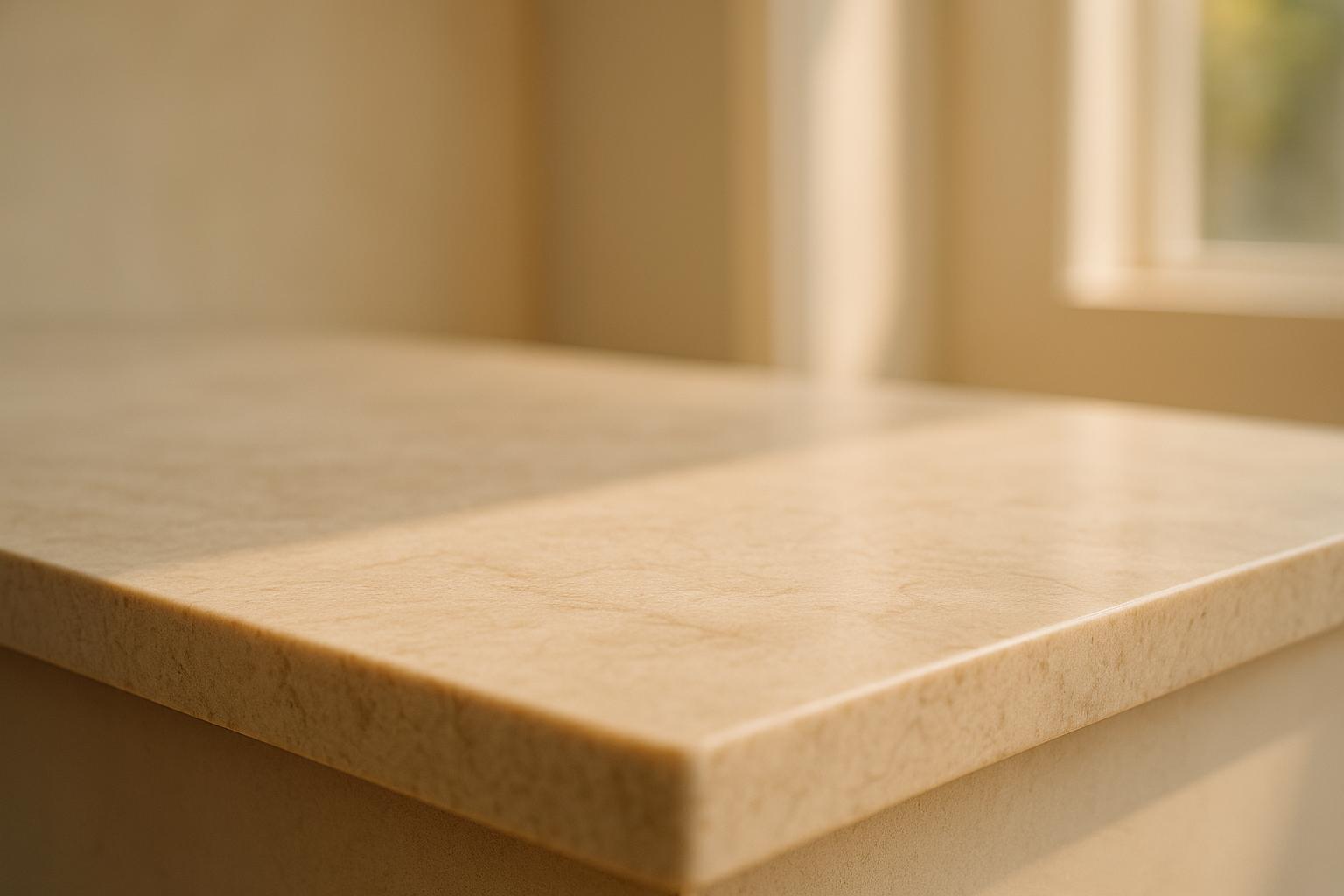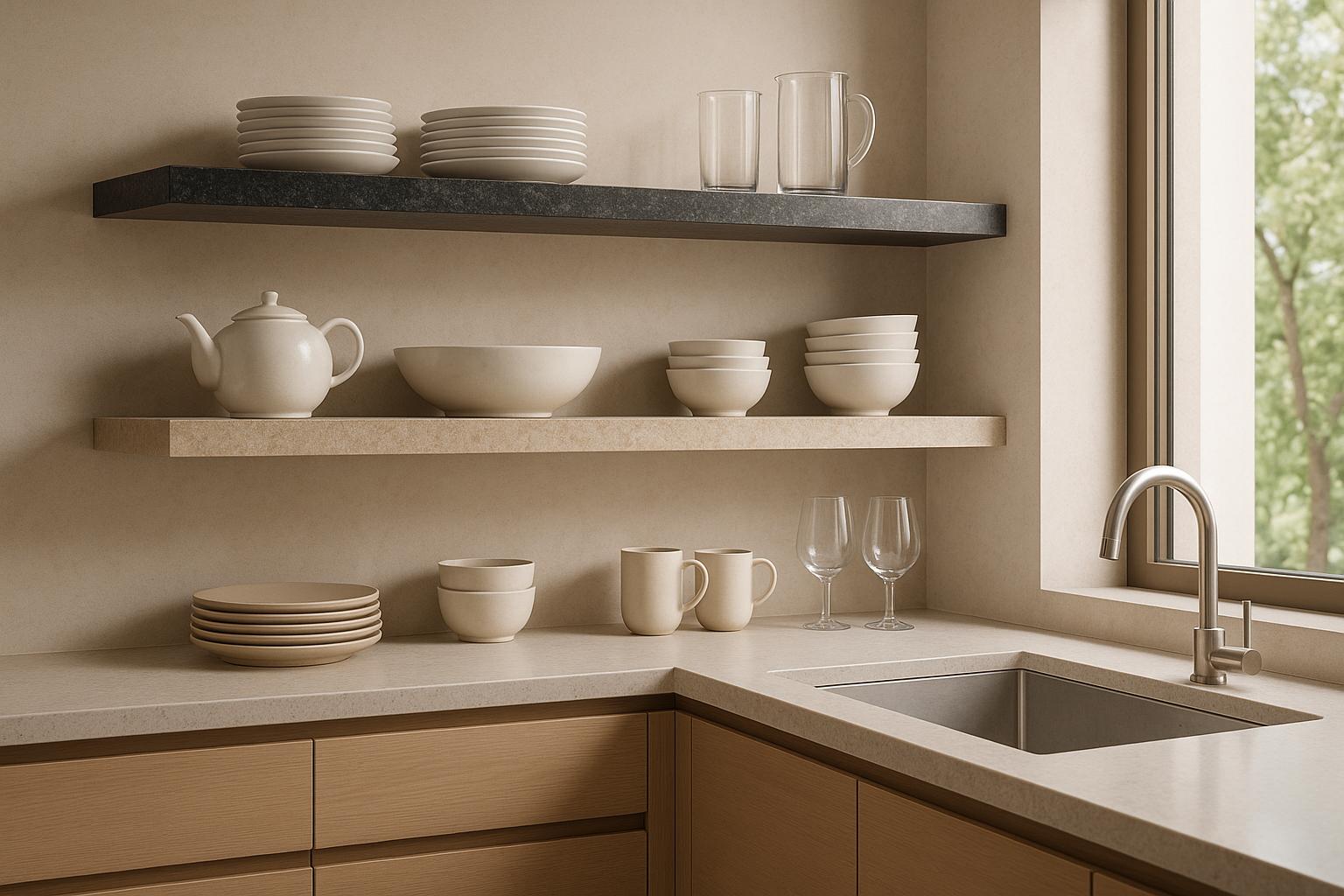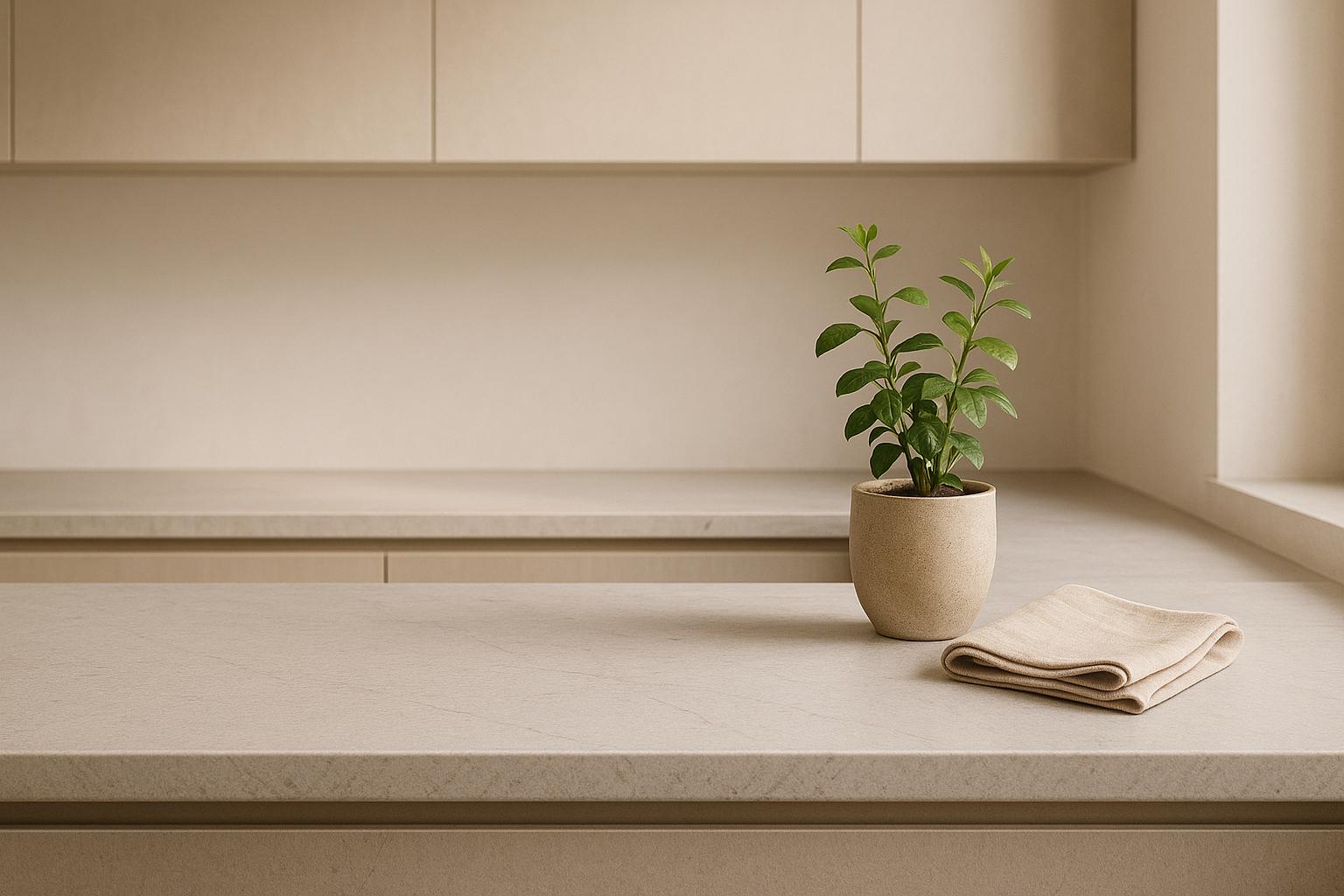Thermal stress can cause cracks in natural stone countertops like granite, marble, and quartz due to temperature changes. This happens when hot or cold items are placed on the surface, causing uneven expansion and contraction. Over time, these stress points lead to visible damage. Here’s what you need to know to protect your countertops:
- Granite is highly heat-resistant, while marble and engineered quartz are more prone to cracking.
- Hot cookware and sudden temperature changes are common causes of thermal stress.
- Thin slabs, poor installation, and pre-existing flaws increase the risk of damage.
- Use trivets, heat pads, or cutting boards to shield surfaces.
- Avoid placing extremely hot or cold items directly on stone.
- Regular sealing and inspections can prolong the life of your countertops.
If you notice cracks or damage, professional restoration services can help repair and prevent further issues. Protecting your stone surfaces with these simple steps can save you costly repairs and maintain their durability over time.
Will heat crack this quartz countertop?
How Temperature Changes Cause Stone Cracks
Understanding how thermal cracking occurs helps make sense of why visible damage eventually appears on stone surfaces.
The Science Behind Thermal Stress and Cracking
When stone heats up, it expands. When it cools, it contracts. This constant cycle of expansion and contraction creates internal stress. The problem becomes more pronounced when different parts of the stone heat or cool at varying rates, causing tension at their boundaries. Imagine a granite countertop: one section near a hot oven warms up, while another part remains cool. The heated area expands, but the cooler section stays the same, creating stress between the two.
This phenomenon is tied to a property called the coefficient of thermal expansion, which measures how much a material changes size with temperature shifts. For natural stones, this expansion ranges from about 0.000004 to 0.000008 inches per inch for every degree Fahrenheit. While these numbers seem small, they add up quickly across large surfaces like countertops.
Stress tends to concentrate at the stone’s weakest points – often along natural grain lines or tiny pre-existing flaws. Over time, repeated heating and cooling cycles turn these weak spots into visible hairline cracks. Once a crack forms, it becomes a vulnerable area, increasing the likelihood of further damage. For instance, placing a hot pot on a cool countertop can cause a sudden 200°F temperature difference, leading to immediate cracking.
Next, let’s explore how different types of stone respond to heat stress.
Stone Types and Heat Resistance
Not all stones handle thermal stress the same way. Their mineral makeup and structure play a huge role in how they respond to temperature changes.
- Granite: Granite is highly heat-resistant due to its dense crystalline structure and low porosity. It can typically withstand temperatures up to 1,200°F without damage, making it one of the most durable options for countertops.
- Marble: Marble, composed mainly of calcium carbonate, is less stable under heat. Its crystalline structure starts to show stress at around 800°F. Additionally, its softer nature makes it more prone to developing cracks from existing flaws.
- Engineered Quartz: Made of 90-95% quartz mixed with resin binders, engineered quartz is a mixed bag. While quartz itself is heat-resistant, the resin can soften or discolor at temperatures above 300°F, making it more vulnerable to thermal damage from hot cookware.
- Onyx: Onyx is one of the most heat-sensitive stones due to its layered structure and high calcium carbonate content. The beautiful translucent bands in onyx are also natural weak points, making it prone to cracking under thermal stress.
- Porcelain: Porcelain slabs are engineered to handle heat exceptionally well, often withstanding temperatures up to 2,000°F. Thanks to their uniform structure, they lack the natural weak points found in other stones, making them highly resistant to cracking.
| Stone Type | Max Temp | Expansion Rate | Crack Risk |
|---|---|---|---|
| Granite | Up to 1,200°F | Low | Low |
| Marble | Up to 800°F | Moderate | Moderate |
| Engineered Quartz | Up to 300°F | Low (stone), High (resin) | High |
| Onyx | Up to 600°F | High | High |
| Porcelain | Up to 2,000°F | Very Low | Very Low |
Knowing the heat tolerance of each stone helps you make smarter choices for kitchen design and care.
Common Risk Factors for Stone Cracking
Thermal stress isn’t just about the type of stone – it’s also influenced by how the stone is used and installed. Several factors can increase the risk of cracking:
- Slab Thickness: Thicker slabs (around 1.25 inches) handle temperature changes better than thinner ones. Ultra-thin slabs, especially those under 0.5 inches, lack the mass needed to evenly absorb and distribute heat, making them more prone to cracking.
- Pre-Existing Micro-Cracks: Tiny flaws, whether natural or caused during quarrying and fabrication, serve as starting points for thermal damage. These micro-cracks expand under stress, eventually becoming visible cracks.
- Improper Installation: Poor installation practices, such as insufficient support or overly tight mounting, can create stress points. Without proper expansion joints, the stone can’t move naturally with temperature changes, leading to cracking.
- Edge Treatments and Cutouts: Sharp corners around sinks or cooktops are especially vulnerable. Stress tends to concentrate at these 90-degree angles, making them common starting points for cracks.
- Surface Finishes: Polished surfaces absorb and reflect heat differently than honed finishes, often heating up more quickly. This can lead to more dramatic temperature differences across the surface.
- Environmental Factors: Kitchens with poor ventilation or stone surfaces near heat sources like fireplaces, heating vents, or large windows experience more extreme temperature swings, increasing the risk of thermal cycling and cracking.
Common Kitchen Situations That Cause Thermal Stress
Stone countertops in kitchens often face heat-related challenges that can lead to cracks or other visible damage. These issues arise from the natural process of expansion and contraction when exposed to temperature changes. Let’s look at a few common scenarios that can put your countertops under stress.
Hot Cookware and Appliances on Countertops
Placing hot pans or appliances directly on a cool stone surface can create sudden, uneven temperature changes. The area in contact with heat expands quickly, while the surrounding cooler stone remains stable. Over time, this repeated thermal movement weakens the stone and may lead to cracks.
Sudden Temperature Changes
When you place something extremely hot or cold on the countertop, it can cause thermal shock. This abrupt shift in temperature creates localized stress, which can eventually result in visible damage.
Repeated Heating and Cooling Effects
Everyday kitchen activities often involve cycles of heating and cooling. Over time, this constant expansion and contraction can wear down the stone’s internal structure. Gradually, this leads to cracks, surface imperfections, or other signs of wear and tear.
sbb-itb-e397dd0
How to Prevent Thermal Stress Damage
Protecting your natural stone surfaces from thermal stress doesn’t have to be complicated. By adopting a few consistent habits, you can help preserve their beauty and durability for years to come.
Use Protective Accessories
Trivets and heat pads are essential tools for shielding your countertops from thermal damage. These accessories create a barrier between hot cookware or appliances and your stone surface. Silicone trivets, which can handle temperatures up to 450°F, are perfect for pots and pans. For larger appliances like slow cookers or electric griddles, heat-resistant mats made from cork or bamboo are excellent options. These materials naturally insulate and can endure prolonged heat exposure without damaging your countertop.
Wooden cutting boards are another great option to protect your stone. Not only do they prevent scratches, but their natural insulation properties also help block heat from transferring to the surface below.
Incorporating these simple barriers into your routine can go a long way toward minimizing thermal stress. However, managing temperature changes directly is just as important.
Avoid Sudden Temperature Changes
Rapid temperature shifts are one of the biggest culprits behind thermal stress. To avoid this, always allow hot cookware to cool on the stovetop before placing it on your countertop. This brief pause helps reduce the intensity of the heat and protects your stone from thermal shock.
Cold items can be equally harmful. Placing frozen foods, ice-filled containers, or items straight from the fridge directly onto your stone can cause contraction stress. To prevent this, let cold items warm up slightly before placing them on the countertop, or use a towel or mat as a buffer.
Whenever possible, aim for gradual temperature changes. For example, if you need to place something warm on your stone surface, consider setting it on a wooden cutting board first to act as an intermediate step. These small adjustments can make a big difference in preventing damage.
Regular Sealing and Inspection
Sealing your natural stone countertops every 12 to 18 months is another key step in protecting them from thermal stress. A good sealant fills tiny pores in the stone, creating a smoother surface that handles temperature changes more effectively. It also helps repel moisture, which can freeze and expand in colder weather, adding to the stress on your stone.
Perform monthly visual inspections to catch potential issues early. Pay close attention to areas around sinks, appliances, or spots where you frequently place hot items. Look for hairline cracks or any irregularities in the surface. Using good lighting and running your hand over the stone can help you identify problems that might not be immediately visible.
If you’re unsure whether your countertop needs resealing, try a water absorption test. Place a small amount of water on the surface and time how long it takes to absorb. If it soaks in within 15 minutes, it’s time to reseal. Properly sealed stone should repel water for several hours.
When in doubt, consider a professional assessment. If you notice changes in your stone’s appearance or texture, a professional can address minor issues with polishing or restoration before they escalate into larger, more costly repairs. Regular maintenance can save you time and money in the long run while keeping your countertops in top condition.
Professional Restoration and Repair Solutions
Even with the best preventive measures, thermal stress can sometimes lead to damage that’s beyond a homeowner’s ability to fix. Recognizing when to bring in the experts can save you from wasted effort, unnecessary expenses, and potential headaches. Let’s explore when professional help is essential and how MI Stone provides effective restoration services.
When to Call a Professional
Certain signs signal it’s time to call in the pros. These include visible cracks, microfractures, discoloration, or warping. These issues often point to compromised structural integrity, and attempting DIY fixes can sometimes make things worse.
Repeated instances of thermal shock, even when the damage appears minor, can also lead to bigger problems over time. Sudden, extreme temperature changes can cause chips or deep fractures, affecting both the appearance and strength of the stone.
Here’s one mistake to avoid: don’t try to cool a heat-damaged surface quickly using ice or cold water. This can actually intensify thermal shock damage by putting even more stress on the stone.
MI Stone‘s Stone Restoration Services

MI Stone specializes in addressing thermal damage with precision. Their team conducts thorough assessments and provides tailored repairs to seamlessly restore countertops. This attention to detail ensures that the repaired surface matches the original in both strength and appearance. This is especially important for natural stone, which can suffer permanent damage when exposed to extreme temperatures – typically those exceeding around 1,470°F (800°C).
For engineered stones, professional expertise is even more critical. Heat damage to these materials often leaves fewer repair options, making it essential to understand which materials best fit your kitchen’s heat exposure and usage patterns.
Benefits of Professional Kitchen Renovations
MI Stone goes beyond repairs, offering a full range of services to create kitchens that are both functional and resilient. Their renovation process includes high-quality materials, custom designs, and strategic planning to position heat sources in ways that reduce thermal stress. They also incorporate proper expansion joints to handle temperature fluctuations, helping to prevent future damage.
Their showroom features a wide selection of materials sourced from around the world, including quartz, granite, marble, onyx, and porcelain. This variety allows you to choose stones that align with your cooking habits while minimizing the risks of heat-related damage.
MI Stone’s renovation services cover more than just countertops. They also address cabinetry and complete kitchen design, ensuring that appliances like ovens and cooktops are positioned to reduce stress on stone surfaces. Their custom template services account for technical details like expansion joints and stress relief areas – small but essential elements for long-term durability. Professional installation also includes advanced sealing techniques, which help the stone handle temperature changes more effectively.
Key Points for Preventing Thermal Stress
Protecting your stone countertops from thermal stress is simple if you follow these essential tips:
- Always use trivets, hot pads, or cutting boards to shield the surface from direct heat.
- Avoid placing extremely hot or cold items directly on the stone.
- Take into account the specific heat tolerance of your stone when choosing and maintaining your countertops.
- If you notice any cracks or damage, reach out to a professional for an assessment.
FAQs
How can I tell if my stone countertop might crack due to thermal stress?
If you’re wondering whether your stone countertop might be vulnerable to thermal stress cracks, think about how often it’s exposed to sudden temperature shifts or consistent high heat, particularly around thinner edges or areas without proper support. Softer stones like marble and onyx are more prone to this type of damage, while tougher options like granite tend to handle heat better.
To reduce the chances of cracks, always use trivets or heat pads instead of placing hot pans or pots directly on the surface. Also, make sure the countertop is well-supported during installation. These simple steps can go a long way in keeping your stone countertop in great shape.
What should I do if I see small cracks or damage on my countertop?
If you spot small cracks or minor damage on your countertop, don’t wait – addressing the issue promptly can prevent it from getting worse. The best course of action is to reach out to a professional who can evaluate the damage and suggest the right repairs. Steer clear of harsh chemicals or abrasive cleaners, as these can make the problem worse.
To keep your countertop in good shape, consider applying a sealant. Sealing helps reduce moisture absorption and lowers the chances of future cracks caused by heat or everyday wear. With regular care and maintenance, you can keep your natural stone countertop looking stunning and durable for years.
How often should I reseal my natural stone countertops to protect them from temperature-related damage?
To keep your natural stone countertops protected from thermal stress and the risk of cracking, make it a habit to reseal them every 1 to 3 years. The timing can vary based on the type of stone, how often the surface is used, and the durability of the sealant. If you’re using high-quality sealants, they might offer extended protection. Always check and follow the guidelines provided by the sealant manufacturer for the best results.



